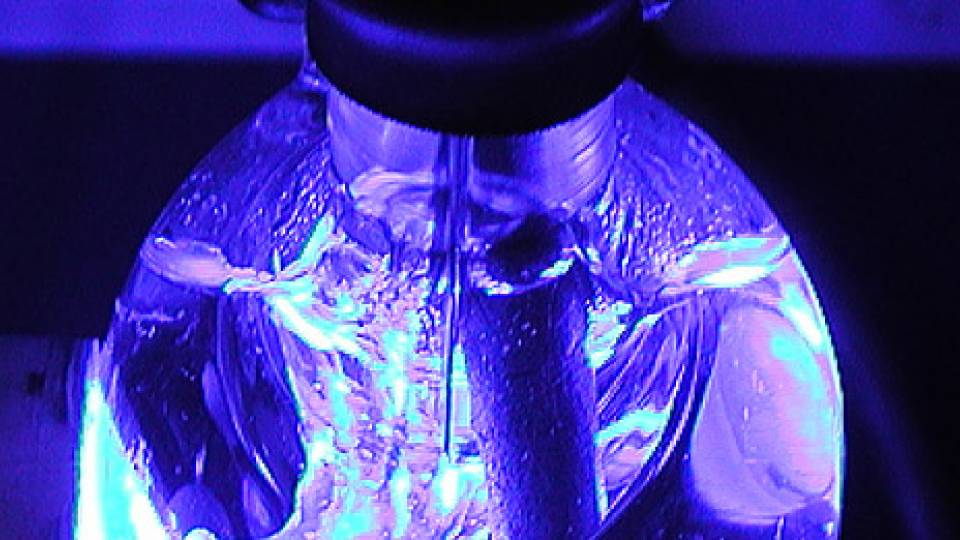Three area high school teachers have been working side-by-side with
Princeton scientists this summer investigating solutions to the world’s
energy problems.
For eight weeks they have been part of a program called Research
Experience for Teachers. The program’s main thrust is to give teachers
real-life lab experience that will inspire and inform their teaching
when they return to their high school classrooms in the fall. But by
all accounts the lab researchers have learned as much from the teachers
as the teachers have learned from the researchers. In one case, a
teacher invented a device that reduces the cost of an important piece
of lab equipment from $60,000 to $30.
Michael Ireland, who teaches physics and precalculus at Perkiomen
School in Pennsburg, Pa., has been commuting an hour and a half every
morning to work in the laboratory of assistant chemistry professor
Stefan Bernhard(Link is external). Bernhard’s lab is trying to use sunlight to coax
hydrogen out of water cheaply and abundantly enough so that it might
one day replace fossil fuels as a source of energy.

Working in Bernhard’s lab, both this summer and last summer, Ireland
said he has learned a tremendous amount about how real research is done
-- for example, he has learned the importance of communication and
collaborative problem solving among lab partners.
But Ireland also has made enormous contributions to Bernhard’s lab,
chiefly in the form of an oxygen sensor that can measure quickly and
reliably how much oxygen has been released from water.
Ireland built his sensor using a semiconductor chip from Texas
Instruments, off-the-shelf parts from RadioShack and a small block of
aluminum, which he hand-machined.
Ireland’s sensor takes measurements just as sensitively and nimbly as the commercially manufactured sensor in the lab.
“Basically I took a bunch of big expensive equipment and made it a lot more portable,” said Ireland.
He also made it very cheaply. Total cost of the lab sensor: $60,000. Total cost of Ireland’s: $30.
“His background enabled him to do things we were unable to do,” said
Bernhard, whose team uses Ireland’s oxygen sensor on a regular basis.
This summer Ireland has been developing a hydrogen sensor as well.
Also participating this summer in the Research Experience for Teachers
are Deborah Cretsinger, who teaches chemistry at East Brunswick (N.J.)
High School, and Steve Whittington, who teaches chemistry at St. Joseph
High School in Metuchen, N.J. The outreach program is sponsored by the
Princeton Center for Complex Materials(Link is external), which is funded by the National
Science Foundation, and the Princeton Institute for the Science and
Technology of Materials(Link is external).
While Ireland has been working on creating hydrogen as a fuel,
Cretsinger and Whittington have been in the labs of two professors --
Jay Benziger(Link is external) in chemical engineering and Andrew Bocarsly(Link is external) in chemistry
-- who are collaborating to develop fuel cells that reliably and
efficiently convert hydrogen or other alternative fuels into
electricity.
“Fuel cells have been around for a long time and you can easily build
one,” Benziger said. “The problem is that they are fickle.”
Benziger has had Cretsinger explore the elastic properties of the
polymer nafion, which acts as a membrane for the fuel cells developed
by Benziger and Bocarsly.
For her research this summer, Cretsinger has created a lab project for
her own students, which involves clamping a weight onto the bottom of
dog-bone shaped pieces of the transluscent nafion and seeing how long
they take to stretch under different conditions.
“Kids want to know how the chemistry I am teaching them applies to
real-life situations,” said Cretsinger, “They are particularly
interested in alternative fuels, so this is a great way to get their
attention.”
Meanwhile in Bocarsly’s lab, Whittington has been adding small
particles -- titanium oxide nanotubes -- to the nafion in an effort to
make it act as a more efficient membrane. This fall Whittington will
take back to his students a demonstration fuel cell that he assembled
in Bocarsly’s lab. It is a re-creation of the very first fuel cell,
invented by Sir William Robert Grove in 1839.
Bocarsly has long understood the benefits of working with teachers. He
is former co-director of Partners in Science, a program that preceded
the Research Experience for Teachers.
“The idea of integrating high school teachers into a real research
group doing cutting edge science has worked exceptionally well,” said
Bocarsly. “There are real, demonstrable benefits.”
A study several years ago by Jay Dubner of Columbia University, also a
co-director of Partners in Science, found that the test scores for
students whose teachers participated in summer lab programs were
significantly higher than scores of students whose teachers had not.
Daniel Steinberg, director of educational outreach for the Princeton
Institute for the Science and Technology of Materials, said that this
summer’s program was unusual in that all of the teachers were working
on projects so closely related to the field of hydrogen energy, giving
them a lot of common ground. “I scheduled a lot of lunch meetings so
that the teachers could talk together about their research experiences
and exchange ideas for new teaching strategies,” he said. “They weren’t
just trading war stories. They learned a lot from one another.”
Program participants receive a weekly stipend to make it easier for
them to forego other summer work. Pending continued funding, organizers
will begin reviewing applications from teachers for next summer’s
program in January.






